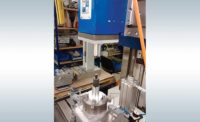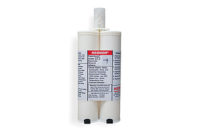Over the past several years, lightweight construction has become a driving force in many areas of transportation. Consumers are demanding more energy-efficient vehicles, and automotive design engineers are responding by incorporating more lightweight materials into the structure of vehicles.
Carbon-fiber-reinforced plastics (CFRP) and glass-fiber-reinforced plastics (GFRP) are two notable lightweight construction materials that offer high stiffness and strength, while allowing for the manufacture of thin structures.
Although these advanced composites offer the lighter weight needed for many designs, CFRP and GFRP are more challenging to join to other components than high-strength sheet metal.
Welds, rivets and screws—the classic joining methods for automotive assembly—don’t necessarily work well with composites. Composites are a matrix of bonded fibers. Punching holes in these materials for screws or rivets damages their laminar structure, which is vital to their strength and stability. In addition, the punched hole must then be sealed using a complex process to prevent delamination of the material. Joining CFRP to metal also presents a high risk of corrosion.
For stable joints and efficient processes, the laminate must remain intact. Ultrasonic welding is one alternative for joining composites, but it has serious disadvantages. It consumes a lot of power and is only suitable for thermoplastic matrix materials. Similarly, higher temperature welding methods are rarely used to join composites, while forming techniques cannot be used because of the material’s low ductility.
Bonding Keeps Composites Intact
An easy and efficient method to join composite materials to other components is adhesive bonding. This nondestructive joining method demonstrates both high material flexibility and good resistance to dynamic forces. With its short cycle times, bonding also facilitates a high degree of automation, a top concern in many manufacturing environments.
Now, fastener manufacturer Böllhoff and adhesives expert DELO have introduced a new method for joining composites, called ONSERT, that combines the advantages of adhesive bonding and threaded fasteners. ONSERT is similar to stud welding. However, instead of welding a metal stud or nut to a metal part, a two-piece fastener is bonded to a composite material with a one-part, light-curing adhesive.
Fast and energy efficient, the process does not require holes in the base materials. It is highly repeatable, and it does not put thermal stress on the components. Compared with stud welding, the ONSERT process is more flexible. Bonding areas are easy to change, even after a design is completed.
The round, flat base of the fastener is made from an amorphous, light-permeable plastic. The plastic can be molded around a metal nut, bolt, ball stud or snap connection. The threaded portion of the fastener is available in various materials, lengths, widths and thread sizes.
To install, the adhesive is dispensed onto the base of the fastener, and the fastener is applied to the composite. Ridges on the base of the fastener, ranging from 0.1 to 0.2 millimeter tall, prevent the adhesive from squeezing out from the joint during installation and ensure a consistent bond-line thickness. The adhesive is then cured with an LED lamp in approximately 4 seconds.
This process can be fully automated, and the bonded connection can be loaded immediately. The mating nut or bolt can be installed as soon as the adhesive is cured. No additional cross-linking occurs after the initial UV exposure. Both internally and externally threaded components are reusable.
Various plastics, such as polycarbonate, polyamide or polyether sulfone, can be used for the transparent base, depending on mechanical requirements and the ambient conditions of use. The only prerequisite is that the plastic must be amorphous. This will allow enough blue light with a wavelength of 400 nanometers to be transmitted through the plastic to cure the adhesive.
The adhesive produces a strong bond to CFRP. Pull-off strength of up to 2,000 newtons can be achieved on CFRP with an ONSERT stud with a base diameter of 25 millimeters. When higher forces are applied, a predetermined breaking point in the base ensures that the laminate of the composite remains intact and no fibers are torn out.
Application Possibilities
This new technique is suitable for a wide range of applications, especially those where components must be fixed but not permanently joined. Although they were developed for joining composites, ONSERT fasteners can also be attached to thin sheet metal, lacquered or polished surfaces, and glass.
In aerospace manufacturing, ONSERT fasteners provide connection points on lightweight structures, such as sandwich materials, CFRP and aluminum.
For example, thousands of weld pins are installed in an airplane to attach cover plates and insulating materials. With ONSERT, these fire-protection components can be attached just like floor panels are now—with threaded fasteners.
In the automotive industry, engineers are increasingly using CFRP, especially for B- and C-pillars. With ONSERT, clips, retainers or studs can be bonded to these pillars for securing wiring harnesses, sensors and other parts. The fasteners can even be attached after cathodic dip coating.
In the appliance industry, ONSERT fasteners can be used to attach glass panels, plastic linings for displays and coated coverings for refrigerators, freezers, stoves, washing machines, dishwashers, vacuums and dryers.
Mechanical Properties
To determine if this new joining method would be suitable for these types of applications, Böllhoff and DELO bonded ONSERT fasteners to four materials: CFRP, untreated magnesium, lacquered aluminum and polypropylene. We then subjected these joints to various tests common in the automotive and aviation industries, including the 85/85 test (in which components are stored at a temperature of 85 C and a humidity of 85 percent) and a standard climate test established by the German Automobile Industry Association (VDA).
The CFRP components were sand-blasted prior to bonding. The lacquered aluminum and polypropylene were cleaned with ethanol. The magnesium components were left untreated.
The tests demonstrated that the ONSERT bases could withstand the demanding environmental conditions and achieved high pull-off strength and shear strength values.
In addition, the stability of the ONSERT fasteners was tested after salt spray exposure for 1,000 hours and storage in Skydrol (a hydraulic fluid used in aviation) for four weeks. We found that the bond strength did not drop significantly after the salt spray test, and it did not drop at all after Skydrol test.
We also measured the amount of torque needed to break off a threaded stud from a CFRP surface at room temperature. Measured at 9 newton-meters, the off-torque was much higher than the 5.5 newton-meters specified as the tightening torque for M5 bolts.
















